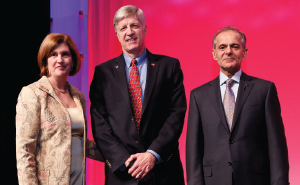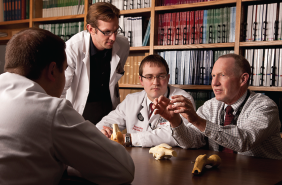
2016 ACR President Joan Van Feldt, MD, MSEd (L), and 2017 ACR President Sharad Lakhanpal, MBBS, MD (R), present Dr. O’Dell with the 2016 ACR Distinguished Clinical Investigator Award.
When it was created in 1982, the Division of Rheumatology and Immunology at the University of Nebraska Medical Center comprised one-and-a-half rheumatologists: its founder, Lynell W. Klassen, MD, MACR, and Gerald Moore, MD, who later received formal training at the NIH and now serves as senior associate dean for academic affairs.
Thirty-five years later, the division has 13 faculty members and is internationally recognized for its expertise and depth of research resources, with an emphasis on investigator-initiated clinical trials, registries and biobanks. Among the award-winning faculty, the commitment to and enthusiasm for teamwork, research and teaching is palpable. Ted R. Mikuls, MD, MSPH, Umbach Professor of Rheumatology, who did his fellowship at the University of Alabama in Birmingham before returning to his alma mater, notes, “Everyone is here because they want to be here. We’re all rowing the same boat together. It really is a team in every sense of the word.”
Studies with the Patient in Mind

Dr. Gerald Moore teaches residents and students.
In addition to his duties as division chief, James O’Dell, MD, serves as residency program director for the Department of Internal Medicine at UNMC. He is also former president of the ACR (2012) and the Rheumatology Research Foundation (2007). He founded the Rheumatoid Arthritis Investigational Network (RAIN) shortly before becoming division chief in 1990.
During his fellowship in rheumatology research at the University of Colorado Health Sciences Center, Dr. O’Dell had been involved with a pivotal methotrexate trial for RA. His idea at UNMC was to reach out to community providers to build substantial patient enrollment numbers and to foster a sense of ownership in the trial design.

Dr. Alan R. Erickson and Dr. Ted R. Mikuls review data.
“RAIN was put together because we wanted to address questions that were clinically important,” he recalls. “We asked physicians in private practice to help us design a trial that had the patient in mind. One example of this was not treating people with placebos when treatments were available.”
One of the landmark studies emanating from that approach, known colloquially as the triple one study, was published in the New England Journal of Medicine in 1996, and was done “on a shoestring,” he says.1 The team secured donations of medications from pharmaceutical companies and showed that the combination of methotrexate (MTX), hydroxychloroquine and sulfasalazine was more effective than MTX alone or the other two medications given together for patients with RA. It was one of the first RA trials to show the effectiveness of combination therapy.
Trial Model Goes Wide

Dr. Amy C. Cannella is a dedicated instructor of the rheumatology fellows in the University of Nebraska Division of Rheumatology & Immunology.



